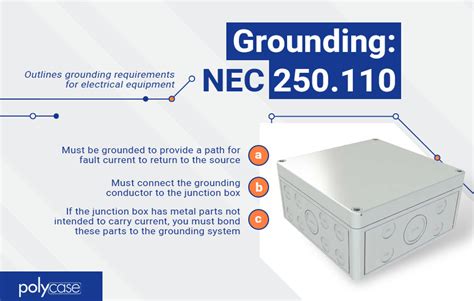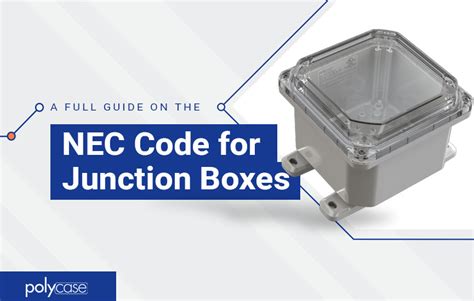do i need metal junction box in attic The junction boxes that contain splices and are not accessible from the ceiling below . Competence, reliability, and individualized advice: You can expect all of this, not .
0 · nec junction box requirements
1 · nec compliant junction boxes
2 · junction box wiring requirements
3 · junction box wiring guidelines
4 · electrical junction box requirements
5 · electrical junction box installation
6 · attic junction box under insulation
7 · are junction boxes legal
Wago is the go-to brand for electricians looking for fast, secure and maintenance-free connections. With the Wago range of junction boxes, terminal blocks and connectors, you’ll get any job done right – and all with the minimum of fuss.The WAGOBOX ® Light junction box is for use with our 224, 260 and 294 Series connectors. WAGOBOX ® LIGHT Suitable for lighting applications using WAGO's 224 series.
nec junction box requirements
Metal boxes aren't very expensive and the covers are easy, and especially can't be beat for fire (arc, etc.) safety. But I'll let someone who can cite code answer as far as covers, etc. Contact the licensing board in your LAHJ.
The junction boxes that contain splices and are not accessible from the ceiling below . Your local electrical code may allow you to place a junction box in the attic. Check with the permitting office before you do this. Metal boxes are stronger, so they will resist .What Are The Rules For Junction Box In Attic? You can't conceal junction boxes in ceilings, walls or non-accessible attics and under-floor areas. In addition, they should not be placed in areas where flammable gases, vapors or dust are .
aerospace cnc machining manufacturing
nec compliant junction boxes
Metal boxes need a proper depth plaster ring and make it harder when a DIY cuts the drywall due to the rounded edges. Plastic boxes and NM are about twice as fast to install over metal. Plastic have the built-in nail vs .
Installing a junction box in the attic has certain requirements that must be met to ensure safety and compliance with electrical codes. Here are some fundamental considerations: Accessibility: The location of the junction . Metal junction boxes can withstand a huge variety of adverse environmental conditions, including crushing impacts, open flames and extremely hot or cold temperatures. They also serve as natural grounding points for .The short answer is ‘no’, a junction box does not necessarily have to be metal. While metal junction boxes are the most common type, they are not the only option available. The main . When I have to put a box in the attic I try to mount it above the insulation layer, but code does allow it to be covered in insulation. Either plastic or metal is OK. I keep a couple of .
The junction boxes that contain splices and are not accessible from the ceiling below should be exposed - not covered by insulation. If enough slack is present in the cables .
It is possible to install a junction box in an attic, but you’ll need to ensure that it is easily accessible. The junction box must be visible in the attic, otherwise, it could be forgotten about and potentially be dangerous. The box can be mounted to . Metal boxes aren't very expensive and the covers are easy, and especially can't be beat for fire (arc, etc.) safety. But I'll let someone who can cite code answer as far as covers, etc. Contact the licensing board in your LAHJ. Your local electrical code may allow you to place a junction box in the attic. Check with the permitting office before you do this. Metal boxes are stronger, so they will resist damage better than plastic boxes.
What Are The Rules For Junction Box In Attic? You can't conceal junction boxes in ceilings, walls or non-accessible attics and under-floor areas. In addition, they should not be placed in areas where flammable gases, vapors or dust are present in an amount that could result in a fire or explosion. Furthermore It is important to cover an . Metal boxes need a proper depth plaster ring and make it harder when a DIY cuts the drywall due to the rounded edges. Plastic boxes and NM are about twice as fast to install over metal. Plastic have the built-in nail vs needing screws to secure a metal box or stapling the box to a . Installing a junction box in the attic has certain requirements that must be met to ensure safety and compliance with electrical codes. Here are some fundamental considerations: Accessibility: The location of the junction box should be easily accessible for future maintenance or .
advertising cnc router manufacturers
Metal junction boxes can withstand a huge variety of adverse environmental conditions, including crushing impacts, open flames and extremely hot or cold temperatures. They also serve as natural grounding points for metal-sheathed wires and other components that require electrical grounding.
The short answer is ‘no’, a junction box does not necessarily have to be metal. While metal junction boxes are the most common type, they are not the only option available. The main purpose of a junction box is to protect electrical wiring and connections from moisture, dust and other contaminants.
When I have to put a box in the attic I try to mount it above the insulation layer, but code does allow it to be covered in insulation. Either plastic or metal is OK. I keep a couple of those surveying flags in my truck specifically for marking boxes like this.
The junction boxes that contain splices and are not accessible from the ceiling below should be exposed - not covered by insulation. If enough slack is present in the cables between the boxes, you may be able to raise them up a bit and mount them on trusses or other exposed framing members without having to run new wire.It is possible to install a junction box in an attic, but you’ll need to ensure that it is easily accessible. The junction box must be visible in the attic, otherwise, it could be forgotten about and potentially be dangerous. The box can be mounted to the side of a joist, or onto its top edge. Metal boxes aren't very expensive and the covers are easy, and especially can't be beat for fire (arc, etc.) safety. But I'll let someone who can cite code answer as far as covers, etc. Contact the licensing board in your LAHJ. Your local electrical code may allow you to place a junction box in the attic. Check with the permitting office before you do this. Metal boxes are stronger, so they will resist damage better than plastic boxes.
What Are The Rules For Junction Box In Attic? You can't conceal junction boxes in ceilings, walls or non-accessible attics and under-floor areas. In addition, they should not be placed in areas where flammable gases, vapors or dust are present in an amount that could result in a fire or explosion. Furthermore It is important to cover an . Metal boxes need a proper depth plaster ring and make it harder when a DIY cuts the drywall due to the rounded edges. Plastic boxes and NM are about twice as fast to install over metal. Plastic have the built-in nail vs needing screws to secure a metal box or stapling the box to a .
Installing a junction box in the attic has certain requirements that must be met to ensure safety and compliance with electrical codes. Here are some fundamental considerations: Accessibility: The location of the junction box should be easily accessible for future maintenance or . Metal junction boxes can withstand a huge variety of adverse environmental conditions, including crushing impacts, open flames and extremely hot or cold temperatures. They also serve as natural grounding points for metal-sheathed wires and other components that require electrical grounding.The short answer is ‘no’, a junction box does not necessarily have to be metal. While metal junction boxes are the most common type, they are not the only option available. The main purpose of a junction box is to protect electrical wiring and connections from moisture, dust and other contaminants.
When I have to put a box in the attic I try to mount it above the insulation layer, but code does allow it to be covered in insulation. Either plastic or metal is OK. I keep a couple of those surveying flags in my truck specifically for marking boxes like this. The junction boxes that contain splices and are not accessible from the ceiling below should be exposed - not covered by insulation. If enough slack is present in the cables between the boxes, you may be able to raise them up a bit and mount them on trusses or other exposed framing members without having to run new wire.

junction box wiring requirements

$599.00
do i need metal junction box in attic|junction box wiring guidelines